As technology continues to grow, shift, and change, so do the ways in which we connect with one another and the ways we’re able to communicate. With so many message format options, sometimes I wonder if it might be better to send a carrier pigeon, just to do something unique that would get the message seen amidst the overload of emails, texts, chats, messages, and other apps we use. These days, the format is everything. You can often tell the importance of a matter by what form it arrives in. If you receive a piece of certified mail, you know that’s important, whereas a text message is the more casual end of the spectrum, and a hand-written thank-you note is somewhere in between (and a nice surprise). Rarely do I pick up the phone when I have a quick question for someone when I can simply text them and get an immediate reply, especially while I’m trying to accomplish five other tasks simultaneously.

Believe it or not, the Torah also teaches us about the decorum of sending a message and the different media we should use. This week’s parshah, Vayishlach, brings the twin brothers together again. The last time these two were together, Esau didn’t care much for his birthright blessing until it had been given to Jacob, and Jacob didn’t care much about his brother’s right to the blessing until his brother threatened to kill him. Now, 20 years or so later, we find the brothers on a path to meet again. Both are now married and are fathers of large clans, and both have large flocks with them.
Throughout this narrative, there are multiple messages sent. If we go back to the beginning of Jacob’s lineage, we see God giving a message to Abraham in the form of a ram stuck in a thicket so that Isaac is not sacrificed. Jacob is often sent messages from God via dreams. Then, there are messages sent via gifts from Jacob to his brother before they reunite. Finally, there’s the person-to-person message interaction announcing that their mother’s nurse has died, which implies that their mother Rebekah has died as well.
Although the types of messages in the Torah are different than those of today, you can imagine what ancient messages might have looked like with today’s technology. Perhaps the visual cue of the ram in a thicket would come as an animated GIF on Abraham’s iPhone. Maybe Noah would have been alerted about the flood with an emergency broadcast system notification.
From the Pony Express to FaceTime to physical face-to-face interactions, humans have always found ways to communicate and ways to show how serious a message is. For each of these moments in the Torah and beyond, the ways in which we communicate remind us how we strive for connection, especially when we’re apart. So . . . write, text, message, email, or maybe even call. Interacting is the important part.



